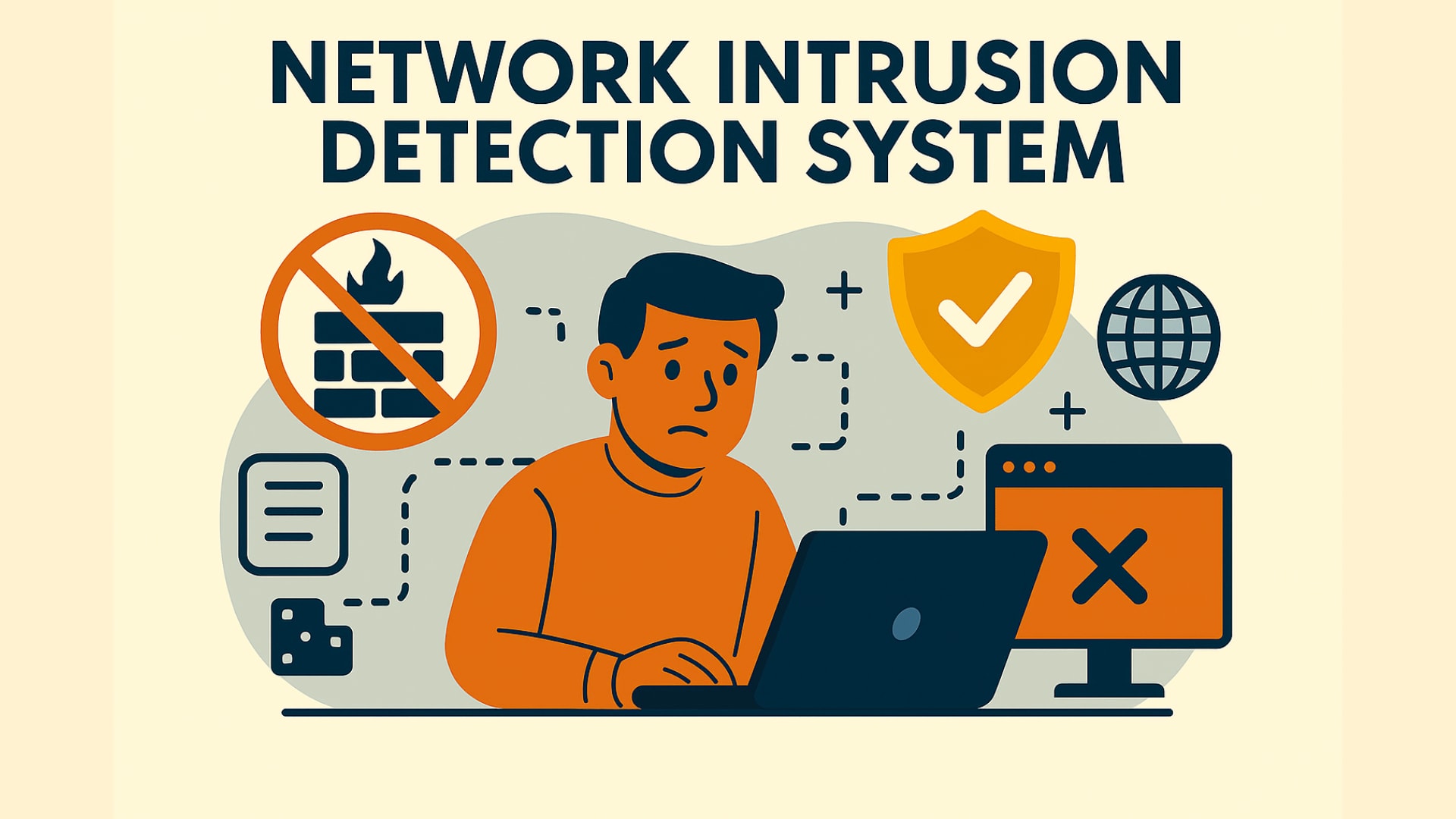
Cyber threats are constantly evolving, making it necessary for businesses to implement robust and adaptive security strategies. While traditional tools like firewalls are essential in blocking malicious traffic, a complete defense requires additional layers of protection. One such critical layer is the Network Intrusion Detection System (NIDS).
Think of NIDS as a vigilant watchguard for your network. It doesn’t actively block traffic like a firewall, rather, it constantly monitors network activity for suspicious behavior, unauthorized access and potential security breaches. The main goal of NIDS is to detect these potential intrusions before they can cause significant damage, adding an important layer of security to your infrastructure.
Table of contents
How Does a Network Intrusion Detection System Work?
NIDS operates by capturing network traffic in real-time and analyzing it for signs of unusual or malicious behavior. This system works by focusing on network packets — small bundles of data that are transferred between devices and services within a network. To effectively monitor network activity, NIDS places sensors at critical points, such as near firewalls or at network segments, where it can capture and analyze traffic as it moves across the network.
When a packet is received, the NIDS carefully inspects various elements, including the origin, destination and content of the packet. It looks for anomalies, such as unexpected traffic patterns or packets that deviate from typical communication behavior. If anything suspicious is found, the system triggers an alert for security teams to investigate further.
The power of NIDS lies in its ability to catch potential threats early. By detecting suspicious behavior at the network level, NIDS can prevent more serious breaches from occurring before they escalate.
Network Intrusion Detection System Methods
To identify potential threats, NIDS uses several methods, often in combination, to ensure comprehensive coverage. Signature-based detection is one of the most common methods, where the system compares network traffic against a database of known attack signatures. If a packet matches a pattern of an already-identified threat, the system generates an alert.
While effective for known attacks, signature-based detection doesn’t offer protection against zero-day attacks — new and unknown threats for which no signature exists. That’s where anomaly-based detection comes in. Instead of looking for specific attack patterns, anomaly detection establishes a baseline of “normal” network activity and flags anything that deviates from it as suspicious. This approach is effective for detecting previously unknown attacks.
Some modern NIDS solutions use a hybrid detection method, combining both signature and anomaly-based detection. This gives organizations the ability to detect both known and unknown threats, enhancing the overall protection while reducing the risk of false positives.
What Can NIDS Monitor?
NIDS offers broad visibility into network traffic, making it capable of monitoring various network protocols, devices and applications. This comprehensive monitoring is essential for identifying a wide range of potential threats. It can analyze network protocols like TCP/IP, HTTP/HTTPS, DNS and SMTP, looking for attempts to exploit weaknesses in these protocols.
In addition to protocols, NIDS also monitors the activity of network devices such as routers, switches and firewalls. It checks for any unauthorized changes or signs that these devices may have been compromised. Furthermore, NIDS inspects applications like web servers, database servers and email systems for signs of attacks like SQL injection or cross-site scripting (XSS).
By having visibility into multiple layers of the network, NIDS provides a more holistic view of your security posture, helping identify threats that may have bypassed other security measures.
Why Use a Network Intrusion Detection System? (Benefits)
The main advantage of implementing a NIDS is its ability to detect potential security breaches before they escalate into major problems. By identifying threats early, NIDS gives businesses the opportunity to respond quickly and mitigate damage. This proactive approach significantly reduces the risk of large-scale data breaches or system compromises.
NIDS also provides valuable visibility into network behavior, which helps businesses understand normal traffic patterns and quickly identify anything unusual. This deeper visibility can uncover vulnerabilities within the network, such as misconfigurations or security weaknesses that attackers could exploit.
In addition to its preventive capabilities, NIDS plays a key role in protecting sensitive information. By monitoring network traffic and access attempts, NIDS helps safeguard data from unauthorized access or theft, an essential function for any business handling sensitive or personal information.
Another critical benefit is regulatory compliance. NIDS helps businesses meet compliance requirements by providing detailed logs and analysis, which are essential for security audits. Whether it’s GDPR, HIPAA or other industry standards, NIDS ensures businesses can meet the security criteria necessary for compliance.
Challenges with NIDS
Despite its advantages, NIDS does come with certain limitations. First and foremost, NIDS is typically a passive system — it monitors and alerts on potential threats but does not actively prevent them. To prevent attacks, NIDS should be paired with other security tools, such as Network Intrusion Prevention Systems (NIPS) or firewalls.
Another challenge is that NIDS can face difficulties in analyzing encrypted traffic. With the increasing use of encryption across networks, NIDS may struggle to inspect the contents of encrypted packets, leaving certain threats undetected.
The potential for false positives is another issue. NIDS, especially those using anomaly-based detection, may flag legitimate network activity as suspicious. This can lead to alert fatigue, where security personnel become overwhelmed by the volume of non-malicious alerts, making it harder to focus on real threats.
Performance can also be a concern, especially in high-speed or high-bandwidth networks. NIDS might struggle to keep up with traffic volumes, potentially missing important data or slowing down network performance.
Finally, NIDS requires ongoing maintenance. To stay effective, the system needs frequent updates to its signature database and tuning of its anomaly detection models to ensure it can detect the latest threats.
NIDS vs. Other Security Tools
While NIDS is an essential security measure, it is important to differentiate it from other network security tools. For example, firewalls primarily filter traffic based on predefined rules, blocking or allowing access to specific services. While a firewall is active in its blocking role, NIDS is passive — it detects threats without blocking traffic.
Another distinction is between NIDS and NIPS (Network Intrusion Prevention Systems). While NIDS detects and alerts on potential threats, NIPS is placed directly in the flow of network traffic and can actively block or prevent attacks from proceeding.
NIDS also differs from Host-based Intrusion Detection Systems (HIDS). HIDS focuses on monitoring activity on individual devices or hosts, such as servers or desktops. In contrast, NIDS provides a broader network-wide view of traffic, making it an essential complement to HIDS in a layered security approach.
Conclusion
A Network Intrusion Detection System (NIDS) is an essential element in any robust cybersecurity strategy. However, it should be considered just one layer in a multi-faceted approach to security. While NIDS is highly effective in monitoring network traffic and identifying suspicious patterns, it is best when combined with other security tools, such as firewalls, Intrusion Prevention Systems (IPS) and endpoint protection solutions.
NIDS excels at detecting potential threats in real-time, but it does not block attacks by itself. For active defense, businesses must pair NIDS with tools that can take immediate action, such as firewalls that filter incoming traffic or IPS that prevent malicious activities from spreading across the network. Together, these systems create a layered defense that improves an organization’s overall cybersecurity resilience.
Moreover, businesses should consider defending against specific threats, such as automated attacks from bots. Bots can conduct a wide range of harmful activities, including data scraping, brute force login attempts and credential stuffing attacks. To effectively prevent such malicious behavior, integrating a privacy-compliant CAPTCHA solution, like captcha.eu, adds an additional layer of protection. By verifying that interactions are coming from legitimate human users, captcha.eu helps prevent bots from overwhelming your network or exploiting vulnerabilities.
When combined with NIDS and other security measures, captcha.eu ensures your network remains protected from automated threats. With these systems working together, businesses can take a proactive stance against evolving cyber threats, ensuring that their networks, data and critical assets stay safe in an increasingly connected world.
FAQ – Frequently Asked Questions
What is a Network Intrusion Detection System (NIDS)?
A Network Intrusion Detection System (NIDS) is a security tool designed to monitor network traffic and identify potential security threats. It examines data packets in real-time and detects suspicious activity, unauthorized access attempts, or malicious behavior within the network.
How does NIDS work?
NIDS works by capturing and analyzing network traffic, looking for deviations from normal traffic patterns. It monitors data packets moving across the network and triggers alerts when it detects any suspicious activity or known attack signatures. NIDS provides visibility into network behavior to detect threats before they escalate.
What can NIDS monitor?
NIDS can monitor various aspects of a network, including:
– Network protocols such as TCP/IP, HTTP/HTTPS, DNS, and SMTP.
– Network devices like routers, switches, and firewalls.
– Applications such as web servers, database servers, and email systems.
– Operating systems and wireless networks for vulnerabilities and potential attacks.
Why is NIDS important for network security?
NIDS is crucial for early threat detection. It helps businesses identify potential security breaches before they escalate, allowing for quick intervention. By monitoring network traffic, NIDS also improves visibility, helps identify vulnerabilities and ensures that sensitive data is protected from unauthorized access.
How do I implement NIDS in my network?
To implement NIDS, you need to install the system’s sensors at key points in your network, such as near firewalls or network segment boundaries. Regular updates to the signature database and periodic tuning of the anomaly detection models are essential for the system to remain effective. It should also be integrated with other security tools, such as firewalls or NIPS, for an enhanced defense strategy.
100 free requests
You have the opportunity to test and try our product with 100 free requests.
If you have any questions
Contact us
Our support team is available to assist you.




